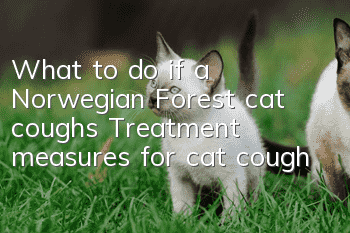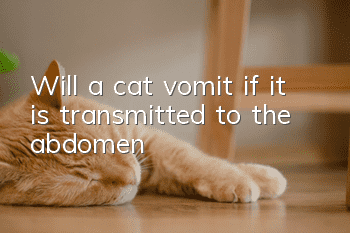What to do if a Norwegian Forest cat coughs? Treatment measures for cat cough

What should I do if a Norwegian Forest cat coughs? Although cat cough is not a particularly serious disease, if it is not treated well, the cough will affect their appetite and sleep, which is still very bad for the cat's health.
1. Causes of cats coughing
Common diseases that cause cough include pulmonary edema, bronchopneumonia, tracheitis, bronchitis, tracheal paralysis, laryngitis, allergies, asthma, etc. Primary cough is mainly caused by colds, such as wind and cold, cold and dampness, sudden changes in climate, etc., which can stimulate the bronchial mucosa, increase mucus secretion, and promote the reproduction of bronchial bacteria.
Infectious diseases that cause cough include infectious bronchitis, feline tuberculosis, etc. Based on other clinical symptoms, necessary examinations should be carried out to find out the cause of the disease.
Parasitic diseases that cause coughing such as heartworm disease. Cough caused by heartworm, circulatory disorder, dyspnea, systolic murmur, anemia, often swollen liver, enlarged abdominal circumference, often accompanied by nodular skin disease, nodules often rupture, and blood vessels around the nodules There are often microfilariae inside.
2. Symptoms of cat cough
Cat’s cough can be divided into two types: dry cough and wet cough. A cough may be accompanied by other symptoms, such as a runny or watery nose and fever.
1. Nature of cough Coughing without phlegm or with very little phlegm is called dry cough. Dry or irritating cough is common in acute or chronic pharyngitis, laryngeal cancer, early stage of acute bronchitis, tracheal compression, bronchial foreign bodies, bronchial tumors, pleural diseases, primary pulmonary hypertension, and mitral stenosis. Cough accompanied by sputum is called wet cough, which is common in chronic bronchitis, bronchiectasis, pneumonia, lung abscess and cavitary tuberculosis.
2. The timing and pattern of coughing Sudden coughing is often caused by inhalation of irritating gases or foreign bodies, lymph nodes or tumors that compress the trachea or bronchial bifurcations. Paroxysmal cough can be seen in whooping cough, endobronchial tuberculosis, and bronchial asthma (variant asthma) with cough as the main symptom. Long-term chronic cough is more common in chronic bronchitis, bronchiectasis, lung abscess and tuberculosis. Nocturnal cough is common in patients with left heart failure and pulmonary tuberculosis. The cause of nocturnal cough may be related to the worsening of pulmonary congestion and increased vagal nerve excitability at night.
3. The timbre of a cough refers to the characteristics of the cough sound. For example, a hoarse cough is mostly caused by inflammation of the vocal cords or tumors compressing the recurrent laryngeal nerve; a cock-like cough manifests as continuous paroxysmal coughs accompanied by high-pitched inspiratory echoes, and is more common in whooping cough, epiglottis, laryngeal diseases or trachea. Pressure; metallic sound cough, common in coughs caused by mediastinal tumors, aortic aneurysms or bronchial cancer directly compressing the trachea; coughing soundLow or weak voice is seen in cats with severe emphysema, vocal cord paralysis, and extremely weak cats.
3. Diagnostic Methods for Cat Cough
If you want to thoroughly examine the cause of your cat’s cough, you need to first examine its lungs with X-rays. A fecal sample is then taken to rule out parasitic infection, or a bronchoscope can be inserted into the cat's nose to check.
1. Complete blood count: Eosinophilia may be present in cats with asthma or heartworm infection.
2. Bronchoalveolar lavage: This can be used to collect samples for cytological examination.
3. Pleural effusion analysis: When pleural effusion appears, such an examination is very important.
4. Heartworm examination: Cat-specific test reagents are available, and a cardiac ultrasound scan may reveal parallel lines of adult worms.
5. Endoscope: It can observe abnormal secretions in the trachea, tracheal stenosis or collapse, and also collect samples required for cytological examination through the endoscopic cytology brush.
IV. Treatment measures for cat cough
Although coughing may be a serious disease, the coughing symptoms themselves will not endanger the cat's life or make the cat severely weak, so there is no need to suppress such symptoms, and the focus should be on the original cause. Diagnosis and treatment of sexual causes.
For example, if a cat is infected with viral rhinotracheitis. With the help of a veterinarian, you can try to use tetracycline injection 0.1 mg/kg body weight, 2 times a day, intravenous injection; gentamicin 10,000 units/kg body weight, dexamethasone 0.5 mg/kg body weight, mixed intramuscular injection, 2 Come and treat it every day. In addition, sealing therapy can be used for conjunctivitis: cephalosporin 0.05g/kg body weight, dexamethasone 0.5mg/kg body weight, 2% procaine 0.15mg/kg body weight mixed, subconjunctival sealing, once a day. You can also use chloramphenicol eye drops and cortisone eye drops alternately, 3-5 times per day.
But in any case, it is best to seek the advice and permission of your veterinarian before giving your cat medicine. Cat coughing may be a minor thing, but if it is not treated properly it can lead to other diseases, which is a big deal. Therefore, it is okay to give medicine to cats, but it must be approved by professionals first.
5. Preventive measures for cats coughing
1. First of all, avoid catching a cold and avoid contact with sick cats.
2. Take care when the weather is coldwarm.
3. Annual vaccination and deworming work must be done in place.
4. Flowers, plants, trees and other items that cats are allergic to should be isolated.
- What are some tips for taking good care of cats? A must-read for novice cat owners!
- Cat’s lung examination, if you don’t know, come and take a look!
- Does the color of your pet’s coat have anything to do with vitamins? The color of your pet’s coat!
- How to prevent cats from being picky eaters
- What to do if your cat has dandruff
- What causes a cat’s mouth to be swollen?
- Why are cats getting thinner and thinner? What are the reasons for cats losing weight!
- There's something hard on the cat's chin
- How long can a male cat live with cryptorchidism?
- What causes cat poop to smell so bad?



